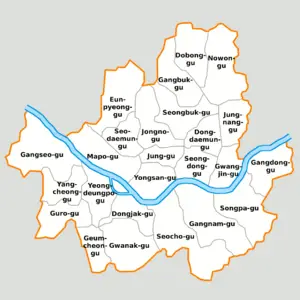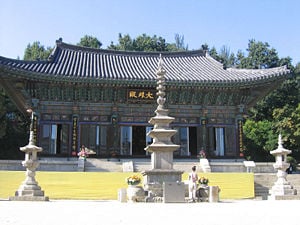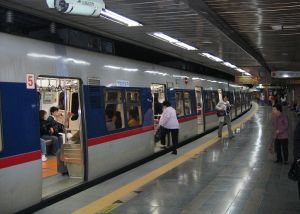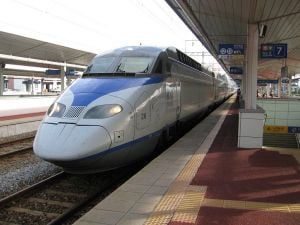Seoul
| Seoul | |
|---|---|
|
225px | |
| Korean name | |
| Revised Romanization | Seoul Teukbyeolsi |
| McCune-Reischauer | Sŏul T'ŭkpyŏlsi |
| Hangul | 서울특별시 |
| Hanja | 서울特別市 |
| Short name | Seoul (Sŏul; 서울) |
| Statistics | |
| Population | 10,356,000 (2006) [2]
(Metro area c. 23,800,000 Ranked 2nd in the world) |
| Area | 605.33 km² [3] |
| Government | (Special City, Capital of Republic of Korea) |
| Administrative divisions | 25 wards (Gu) |
| Region | Seoul National Capital Area |
| Dialect | Seoul dialect |
| Location map | |
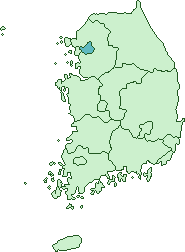
| |
Seoul listen ▶ ('sʌ ul), the capital of South Korea, sits on the Han River (Korea) in the country's northwest situated about thirty miles (~50 km) south of the de-militarised zone (DMZ). Seoul, an ancient city, served as the historic capital of the Baekje Dynasty (18 B.C.E. – 660 C.E.) and Joseon Dynasty (1392-1910). The city became the capital of South Korea in 1394, two years after the establishment of the Joseon Dynasty. [1]Designated the status of a Special City, the national government directly administers Seoul.
The largest city in South Korea with over ten million people, Seoul also numbers among the largest cities in the world.[2] Seoul, one of the world's most densely populated major cities, covers an area of only 605 square kilometres, smaller than New York City or Tokyo. Seoul, one of the world's most digitally-connected cities, has more Internet users than all of sub-Saharan Africa, excluding South Africa.[3]
The Greater Seoul metropolitan area, including the major port city of Incheon, has almost twenty three million inhabitants placing second on the most list of most populous metropolitan areas in the world after Greater Tokyo. Almost one fourth of South Korea's population lives in the Seoul National Capital Area, and nearly one half in the Greater Seoul Area. Seoul serves as the country's political, cultural, and economic centre, as well as a centre for international business. The city has played a key role in South Korea's economic development and has been referred to as the "Miracle on the Han River."
Seoul hosts more than three million registered vehicles, making widespread traffic congestion common. In recent years, the metropolitan government has undertaken extensive clean up of the city's air and water pollution, highlighting the revival of Cheonggyecheon, a stream that flows through Seoul city centre, as a recent major urban beautification project.
History
The history of Seoul traces to 18 B.C.E. as the capital of the Baekje Kingdom. During the Goryeo Dynasty, Seoul had the name Hanseong, picking up the current name Seoul during the Joseon Dynasty designated Seoul. During the colonization period, Japan demolished many historical parts of Seoul. The North Koreans almost entirely destroyed the city during the Korean War, but an aggressive restoration policy in the 1960s and 1970s rebuilt the city rapidly. During the 1990s, the government restored some important historical buildings, including Gyeongbokgung, the main royal palace of the Joseon dynasty.
Names
The city has been known in the past by the successive names Wiryeseong (위례성; 慰禮城; Baekje), Hanyang (한양; 漢陽) and Hanseong (한성; 漢城; Goryeo and Joseon). Seoul derives from the ancient Korean word Seorabeol or Seobeol, meaning "capital city," referring to Gyeongju, the capital of Silla.
Chinese name
Unlike most place names in Korea, "Seoul" has no corresponding hanja (Chinese characters used in the Korean language), and Chinese-speaking countries have continued to refer to the city by its former name "Hànchéng" (meaning "City on the Han River" Traditional: 漢城; Simplified: 汉城; Korean: "Hanseong"). In January 2005, the Seoul Metropolitan Government requested that the Chinese name of the city change to "Shǒu'ěr" (首爾/首尔; Korean: 수이 Su-i). That represents a close transliteration of Seoul in Mandarin Chinese, where 首 (shǒu) can also mean "first" or "capital."
Chinese communities have gradually adopted that new name. That change, intended for speakers of Chinese only, has no effect on the Korean language name; unlike standard hanja, the government chose the Chinese characters that best represent the Korean pronunciation of a native Korean word.
Geography
Seoul sits in northwest South Korea, comprising 605.52km² of area while roughly bisected into northern and southern halves by the Han River[4]. Eight mountains border the city, as well as the more level lands of the Han River plain.
Climate
In common with the rest of South Korea, Seoul has atemperate and continentalclimate, despite water surrounding South Korea on three sides.[5] Summers, generally hot and wet, experience monsoons from June until September. August, the hottest month, has an average temperature of 22 °C to 30 °C (72 °F to 86 °F). Winters, often cold compared to places at a similar latitude, have an average January temperature of -7 °C to 1 °C (19 °F to 33 °F). Generally drier than summers, Seoul averages twenty eight days of snow each Winter.
Cityscape
The old Joseon Dynasty city constitutes the traditional heart of Seoul, now the downtown area with most palaces, government offices, corporate headquarters, hotels, and traditional markets. That area occupies the valley of Cheonggyecheon, a stream that runs from west to east through the valley before emptying into the Han River. For many years the stream had been covered by concrete, unitl recently restored through an urban revival project. Bukhan Mountain sits to the north of downtown while to the south stands the smaller Namsan.
The old suburbs of Yongsan-gu and Mapo-gu, and the Han River lay further south. The newer and wealthier areas of Gangnam-gu and surrounding neighborhoods lay across the Han River. The World Trade Center of Korea, located in Gangnam-gu, hosts many expositions and conferences. Also in Gangnam-gu, the COEX Mall, a large indoor shopping and entertainment complex, has been built. Bamson, an island in the middle of the Han River near Youido, downstream from Gangnam-gu, serves as the home to the National Assembly, major broadcasting studios, and a number of large office buildings, as well as the Korea Finance Building and the world's largest Pentecostal church. In Songpa-gu, on the south side of the Han River, upstream from Gangnam-gu, the the Olympic Stadium, Olympic Park, and Lotte World have been built. Namhan Mountain and Gwanak Mountain lie aouth of the sprawling Gangnam area.
Major modern landmarks include the Korea Finance Building, Seoul Tower, the World Trade Center, the six-skyscraper residence Tower Palace (usually designated as residence for the upper-classes), and I-Park Apartments (a luxury apartment located in Gangnam-gu). Those, and high-rise office buildings, like the Seoul Star Tower and Jongro Tower, dominate the city's skyline. Seoul has the largest number of skyscrapers in Asia. Seoul now plans to build a 580-metre business center in Sangam Digital Media City district and planning on an 800-metre Lotte World 2 Tower in Jamsil (pronounced "Jam-shil") district.
Urban and civil planning played a key role in the first designs of Seoul as a capital in the 14th century. The Royal Palaces of the Joseon Dynasty still remain in Seoul, with the main palace (Gyeongbokgung) currently restored to its original form. Today, eight major subway lines stretching for more than 250 kilometers, with a ninth and tenth line in planning.
Jongno, meaning "Bell Street," the most historically significant street in Seoul, serves as the home to Bosingak, a pavillion containing a large bell. The bell signaled the different times of the day, controlling the four gates to the city. Now the bell only rings at midnight on New Year's Eve, when the bell sounds thirty-three times. In an acception to tradition, the city rang the bell on the day that President Kim Dae-jung took office.
Seoul's most important streetcar line ran along Jongno until replaced by Line 1 of the subway system in the early 1970s. Other notable streets in downtown Seoul include Euljiro (을지로; 乙支路), Teheranno (테헤란路), Sejongno (세종로; 世宗路, Chungmuro (충무로; 忠武路), Yulgongno (율곡로; 栗谷路), and Toegyero (퇴계로; 退溪路).
Administrative divisions
- Main article: Gu of Seoul
Seoul is divided into 25 gu (구; 區) (wards), which are sub-divided into 522 dong (동; 洞), which are sub-divided into 13,787 tong (통; 統), which are further divided into 102,796 ban in total.
- Dobong-gu (도봉구; 道峰區)
- Dongdaemun-gu (동대문구; 東大門區)
- Dongjak-gu (동작구; 銅雀區)
- Eunpyeong-gu (은평구; 恩平區)
- Gangbuk-gu (강북구; 江北區)
- Gangdong-gu (강동구; 江東區)
- Gangnam-gu (강남구; 江南區)
- Gangseo-gu (강서구; 江西區)
- Geumcheon-gu (금천구; 衿川區)
- Guro-gu (구로구; 九老區)
- Gwanak-gu (관악구; 冠岳區)
- Gwangjin-gu (광진구; 廣津區)
- Jongro-gu (종로구; 鍾路區)
- Jung-gu (중구; 中區)
- Jungnang-gu (중랑구; 中浪區)
- Mapo-gu (마포구; 麻浦區)
- Nowon-gu (노원구; 蘆原區)
- Seocho-gu (서초구; 瑞草區)
- Seodaemun-gu (서대문구; 西大門區)
- Seongbuk-gu (성북구; 城北區)
- Seongdong-gu (성동구; 城東區)
- Songpa-gu (송파구; 松坡區)
- Yangcheon-gu (양천구; 陽川區)
- Yeongdeungpo-gu (영등포구; 永登浦區)
- Yongsan-gu (용산구; 龍山區)
Demographics
Nearly all of Seoul's residents are Korean, with some small Chinese and Japanese minorities. Today, there are an estimated more than 200,000 foreign nationals living in Seoul. These include people from South Asia, Southeast Asia, Central Asia, Africa, Europe, Oceania, and the Americas. The crime rate in Seoul is very low. Although about half of the population describe themselves as not religious, two major religions in Seoul are Buddhism and Christianity (each around 25%). Other religions include Shamanism and Confucianism, the latter seen more as a pervasive social philosophy rather than a religion.
Economy
As headquarters for some of the world’s top corporations such as Samsung, LG Group, Hyundai, and Kia Motors, the service sector in Seoul has thrived, bringing development and a healthy economy to the country as a whole. South Korea derives 63.2% of its GDP from the service sector, which is above the average for the upper income nations(World Bank 2004). The major exports are electronics, automobiles, and machinery. This economic development has also helped keep unemployment low at around 3.4% and ensured that the informal economy of Seoul is negligible. Foreign direct investment is also high at around $2 billion(World Bank 2004); however, South Korea was expected to be threatened with a slowing economy which could hurt it and its development. As one of the "Four Asian Tigers," it experienced rapid growth in the 1990s. Nonetheless, the CIA fact book denotes that South Korea has shown a moderate economic growth between 2003 and 2006 by 4-5% on average. The constriction of consumer consumption has suffered the maximizing economic growth of South Korea, but the consumption has begun to be rekindled gradually. Seoul and South Korea have a thriving economy that helps to make South Korea a major player in the world economy. As the center of the service sector for South Korea, Seoul is the hub around which the economic growth and health of the country reside in order to ensure the continuing growth of the nation. Seoul's per capita GDP in 2005 was US$ 30,510.
Education
- See also: Education in South Korea, List of universities in Seoul
There are a large number of universities in Seoul. Most of the country's most prestigious universities are located in Seoul, including the so-called "SKY" schools: Seoul National University, Korea University, and Yonsei University.
Culture


Historical structures and museums
The Joseon Dynasty built "Five Grand Palaces" in Seoul:
- Changdeokgung (창덕궁; 昌德宮)
- Changgyeonggung (창경궁; 昌慶宮)
- Deoksugung (덕수궁; 德壽宮)
- Gyeongbokgung (경복궁; 景福宮)
- Gyeonghuigung (경희궁; 慶熙宮)
This is a relatively minor palace:
- Unhyeongung (운현궁; 雲峴宮)
Museums
- National Museum of Korea(국립중앙박물관; 國立中央博物館)
- National Folk Museum(국립민속박물관; 國立民俗博物館)
- War Memorial(전쟁기념관; 戰爭紀念館)
Outside the metropolitan area:
- Samjeondo Monument
- Namhansanseong(남한산성; 南漢山城)
- Bukhansanseong(북한산성; 北漢山城)
- Namsan Park(남산공원; 南山公園)
Temples and shrines
- Jongmyo(종묘; 宗廟)
- Dongmyo(동묘; 東廟)
- Munmyo(문묘; 文廟)
- Jogyesa(조계사; 曹溪寺)
- Hwagyesa(화계사; 華溪寺)
- Bongeunsa (봉은사; 奉恩寺)
Parks and outdoor attractions
Due to the efforts of the government with respect to the environment, Seoul's air pollution levels are now on par with those of Tokyo and far lower than those of Beijing.[citation needed] Seoul's metropolitan area accommodates six major parks, including Seoul Forest, which opened in mid-2005. The Seoul National Capital Area also contains a green belt aimed to prevent the city from sprawling out over the neighboring Gyeonggi Province. These lush green areas are frequently sought after by people resting on the weekend and during vacations.
In addition, the Seoul area is also home to three amusement parks: Lotte World, Seoul Land, and Everland (located in the nearby city of Yongin). Of these, Lotte World is the most frequently visited. Other recreation centres include the former Olympic and World Cup stadium, the Korea Finance Building, and the City Hall's public lawn.
Sports
Seoul hosted the 1988 Olympic Games as well as the 1988 Paralympic Games and also served as one of the host cities of the 2002 FIFA World Cup.
Taekwondo is Korea's national sport and Seoul is the location of the Kukkiwon, also known as the World Taekwondo Federation (WTF), the world headquarters of taekwondo.
The city is home to two baseball teams in the KBO: the Doosan Bears and the LG Twins & two basketball teams in the KBL: the Seoul Samsung Thunders and Seoul SK Knights.
There is one professional football club in Seoul, FC Seoul, which plays in the K-League. Two K3 League teams are based in the capital, Seoul United and Eungpyeong Chung-goo FC.
Festivals
- Hi Seoul Festival
- SICAF
Transportation
Seoul's transportation boom dates back to the era of the Korean Empire, when the first streetcar lines were laid and a railroad linking Seoul and Incheon was completed. Today, as a result of the diversification of Seoul's transportation network, it has become a great transportation hub for Asia.
Airports
There are two airports that serve Seoul. Gimpo International Airport, formerly in Gimpo but annexed to Seoul in 1963, was the only airport for Seoul from its original construction during the Korean War. Multiple airports were built in and around Seoul immediately before, during, and after the war. The most famous was on Yeouido, which once served as the country’s gateway to the world.
Upon opening in March 2001, Incheon International Airport on Yeongjong island near Incheon changed the role of Gimpo Airport significantly. Incheon is now responsible for almost all international flights and some domestic flights, while Gimpo serves only domestic flights with the exception of flights to Haneda Airport in Tokyo. This has led to a significant drop in flights from Gimpo Airport.
Meanwhile, Incheon International Airport has become, along with Hong Kong and Singapore, a major transportation centre for East Asia. The 2005 AETRA passenger survey, jointly administered by the IATA and Airports Council International, voted it the best airport in the world.[6] It was named by Skytrax as the world's 5th best airport for 2006.[7]
Incheon and Gimpo are linked to Seoul by highways, and Gimpo is also linked by subway (line #5). The Incheon International Airport Railroad, a rail line connecting Incheon Airport to Gimpo Airport opened in March 2007, but the line to Seoul Station in central Seoul will take at least a year more to open. Shuttle buses transfer passengers between Incheon and Gimpo airports.
Bus
Seoul's bus system is operated by the Seoul Metropolitan Government, with four primary bus configurations available servicing most of the city.
Seoul has many big intercity/express bus terminals. These buses are connecting Seoul and cities all around Korea. Major bus terminals are
- Seoul Express Bus Terminal in Seocho-gu
- Central City in Seocho-gu
- Seoul Nambu Terminal, also in Seocho-gu
- Dongseoul Bus Terminal in Gwangjin-gu
- Sangbong Terminal in Jungnang-gu
Subway
Seoul has eight subway lines that interlink every district of the city with one another and with the surrounding area. The majority of the population now uses the public transportation system due to its convenience and low cost. With more than 8 million passengers a day, Seoul has one of the busiest subway systems in the world. In addition, in order to cope with all of these transportation modes, Seoul's metropolitan government employs several mathematicians to coordinate the subway, bus, and traffic schedules into one timetable.
Train
Seoul is connected to every major city in Korea by railroad. Seoul is also linked to most major Korean cities by the KTX bullet train which features a normal operation speed of more than 300 km/h, making commuting between cities extremely convenient for commuters and tourists. Major railroad stations include:
- Seoul Station, Jung-gu - Gyeongbu line (KTX/Saemaul/Mugunghwa-ho), Gyeongui line (Saemaul/Commuter)
- Yongsan Station, Yongsan-gu - Honam line (KTX/Saemaul/Mugunghwa), Jeolla/Janghang lines (Saemaul/Mugunghwa)
- Yeongdeungpo Station, Yeongdeungpo-gu - Gyeongbu/Honam/Janghang lines (Saemaul/Mugunghwa)
- Cheongnyangni Station, Dongdaemun-gu - Gyeongchun/Jungang/Yeongdong/Taebaek lines (Mugunghwa)
Sister cities
Seoul has many sister cities. Washington, D.C. is the latest to become a sister city of Seoul.[8] The year each relationship was formed is shown in parentheses below.
|
|
Gallery
- Khitai6.jpg
Olympic Park
- Seoul Cheonggyecheon river.jpg
Chunggye'cheon in Seoul
- Seoul Building63.jpg
63 Building in Yeido, the third tallest building in Korea
- Seoul.Tower.01.jpg
Underside view of Seoul Tower
- Wtc coex seoul.jpg
World Trade Center Seoul
- Downtownseoul.JPG
Northren area of Seoul
- View of YangJe-Cheon.jpg
Yangjaecheon stream and skyline
See also
- Geography of South Korea
- Large Cities Climate Leadership Group
- Mayor of Seoul
- List of Korea-related topics
- List of cities in South Korea
- Names of Asian cities in different languages
- Seoul National Capital Area
ReferencesISBN links support NWE through referral fees
- ↑ http://english.seoul.go.kr/today/about/about_01quick.htm- About Seoul - official website
- ↑ http://www.citymayors.com/features/largest_cities1.html CityMayors The World's Largest Cities
- ↑ http://www.itu.int/wsis/tunis/newsroom/stats/ World Summit on the Information Society
- ↑ http://english.seoul.go.kr/today/about/about_01quick.htm - About Seoul - official website
- ↑ http://www.bbc.co.uk/weather/world/country_guides/results.shtml?tt=TT002800 BBC Weather - Country Guide
- ↑ Airport Service Excellence Awards for 2005. ACI (2006-03-07). Retrieved 2006-08-25.
- ↑ Airport of the Year 2006. World Airport Awards. Skytrax. Retrieved 2007-02-25.
- ↑ Seoul Metropolitan Government websiteInternational Cooperation.[1]
External links
Official sites
Tourism and living information
- Travel guide to Seoul from Wikitravel
- Go Seoul City: Comprehensive guide to the city
- Highlights of Seoul: by Korean National Tourism Organization
- Seoul Style - "Hip tips on life in Seoul"
- Seoul, South Korea Travel & culture portal
- Seoul on the Galbijim Wiki
Maps and images
- Photos of Seoul
- Seoul Photo Gallery
- Map of Seoul (Korean)
- Map of Central Seoul
- Seoul subway map (ZIP file)
- Map of Seoul and environs
- Architecture and Skyscraper Community of Korea
-
- Mapping from Multimap or GlobalGuide or Google Maps
- Satellite image from WikiMapia
- Mapping from OpenStreetMap
Others
- {{{2}}} at the Open Directory Project
Dobong-gu · Dongdaemun-gu · Dongjak-gu · Eunpyeong-gu · Gangbuk-gu · Gangdong-gu · Gangnam-gu · Gangseo-gu · Geumcheon-gu · Guro-gu · Gwanak-gu · Gwangjin-gu · Jongno-gu · Jung-gu · Jungnang-gu · Mapo-gu · Nowon-gu · Seocho-gu · Seodaemun-gu · Seongbuk-gu · Seongdong-gu · Songpa-gu · Yangcheon-gu · Yeongdeungpo-gu · Yongsan-gu
Template:Neighbourhoods of Seoul
1896: Athens • 1900: Paris • 1904: St. Louis • 1908: London • 1912: Stockholm • 1920: Antwerp • 1924: Paris • 1928: Amsterdam • 1932: Los Angeles • 1936: Berlin • 1948: London • 1952: Helsinki • 1956: Melbourne • 1960: Rome • 1964: Tokyo • 1968: Mexico City • 1972: Munich • 1976: Montreal • 1980: Moscow • 1984: Los Angeles • 1988: Seoul • 1992: Barcelona • 1996: Atlanta • 2000: Sydney • 2004: Athens • 2008: Beijing • 2012: London
Credits
New World Encyclopedia writers and editors rewrote and completed the Wikipedia article in accordance with New World Encyclopedia standards. This article abides by terms of the Creative Commons CC-by-sa 3.0 License (CC-by-sa), which may be used and disseminated with proper attribution. Credit is due under the terms of this license that can reference both the New World Encyclopedia contributors and the selfless volunteer contributors of the Wikimedia Foundation. To cite this article click here for a list of acceptable citing formats.The history of earlier contributions by wikipedians is accessible to researchers here:
The history of this article since it was imported to New World Encyclopedia:
Note: Some restrictions may apply to use of individual images which are separately licensed.


